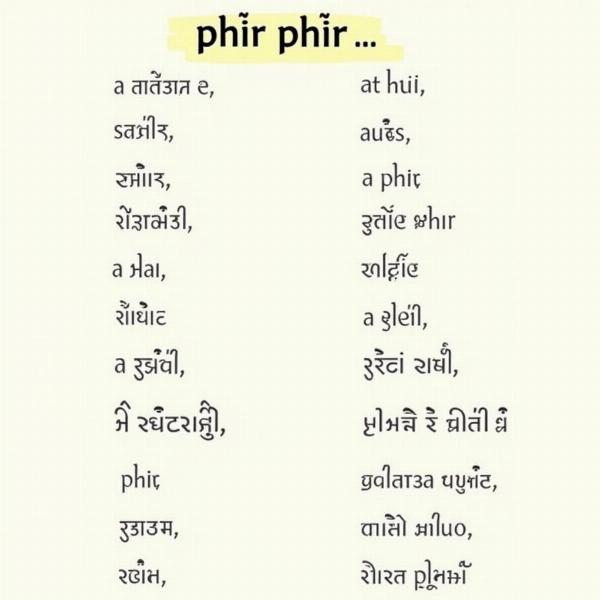Understanding the nuances of time-related words like “then after” can be tricky when learning Hindi. This guide explores the various ways to express “then after” in Hindi, providing clear explanations and practical examples to help you master this concept. We’ll cover the most common Hindi equivalents, discuss their subtle differences, and demonstrate their usage in everyday conversations. This will empower you to communicate more effectively and naturally in Hindi.
Decoding “Then After” in Hindi
While a direct, single-word translation for “then after” doesn’t exist in Hindi, the meaning is conveyed using different words and phrases depending on the specific context. Let’s explore some of the most common options:
Using “phir” (फिर)
“Phir” (फिर) is a versatile word in Hindi, often translating to “then,” “again,” or “afterwards.” It signifies the occurrence of an action following another. When used to convey the meaning of “then after,” it implies a sequential order of events.
- Example: Maine khana khaya, phir bazaar gaya. (मैंने खाना खाया, फिर बाजार गया।) – I ate food, then (after that) I went to the market.
Using “uske baad” (उसके बाद)
“Uske baad” (उसके बाद) literally translates to “after that.” It clearly indicates a subsequent action and is a more formal way to express “then after.”
- Example: Usne apna kaam khatam kiya, uske baad ghar chala gaya. (उसने अपना काम खत्म किया, उसके बाद घर चला गया।) – He finished his work, then after (after that) he went home.
Using “fir se” (फिर से)
“Fir se” (फिर से) translates to “again” or “once more.” While not directly “then after,” it can imply a repeated action following a previous one. This can be used in contexts where “then after” suggests a recurring sequence.
- Example: Mai gir gaya, fir se uth khada hua. (मैं गिर गया, फिर से उठ खड़ा हुआ।) – I fell, then after (then again/after that) I stood up.
 Examples of "Phir" Usage in Hindi
Examples of "Phir" Usage in Hindi
Contextual Usage of “Then After”
The most appropriate Hindi translation of “then after” depends heavily on the context. Consider the following examples:
- Sequential Actions: When describing a series of events, “phir” (फिर) or “uske baad” (उसके बाद) are ideal.
- Repeated Actions: “Fir se” (फिर से) works well when an action is performed again after a previous occurrence.
- Emphasis on Time: For a stronger emphasis on the time elapsed between actions, phrases like “kuch der baad” (कुछ देर बाद) – “after some time” – can be used.
Common Questions about “Then After” in Hindi
-
What is the most common way to say “then after” in Hindi? “Phir” (फिर) and “uske baad” (उसके बाद) are the most frequently used options.
-
Is there a single word in Hindi that directly translates to “then after”? No, the concept is usually expressed using phrases.
-
How do I choose the right word or phrase? Consider the specific context and the nuance you want to convey.
Mastering Time-Related Expressions
Understanding “then after” is just one step towards mastering time-related expressions in Hindi. Exploring related words like “baad mein” (बाद में) – “later” – and “pehle” (पहले) – “before” – will further enhance your communication skills.
Conclusion
While a single-word equivalent for “then after” doesn’t exist in Hindi, the language offers various ways to express this concept effectively. By understanding the nuances of words like “phir,” “uske baad,” and “fir se,” and considering the context of your conversation, you can communicate accurately and naturally in Hindi. Keep practicing, and you’ll soon master these essential time-related expressions.
FAQ
- What if I use the wrong word for “then after”? Native speakers will likely understand your intended meaning from the context, but using the correct word or phrase will enhance your fluency.
- Are there any regional variations in the usage of these words? While the core meaning remains consistent, slight variations in pronunciation or preferred usage might exist across different regions.
- Where can I find more examples of these words in use? Hindi movies, TV shows, and books are excellent resources for observing these words in natural conversation.
- Can “then after” be used interchangeably with “after that” in Hindi? Yes, in many contexts, the Hindi equivalents for “then after” can be used interchangeably with “after that”.
- How can I improve my overall understanding of Hindi grammar? Consistent practice, exposure to the language through various media, and seeking guidance from language experts can significantly improve your grammatical understanding.
Meaning-Hindi.in is your trusted partner for professional Hindi translation services. We specialize in various areas, including business and legal document translation, technical manual translation, website localization, and academic translation. Our team of expert linguists ensures accurate and culturally sensitive translations, helping you connect with your target audience effectively. Need help with your Hindi translation project? Contact us today at [email protected] or call us at +91 11-4502-7584. Meaning-Hindi.in is dedicated to providing high-quality language solutions tailored to your specific needs.